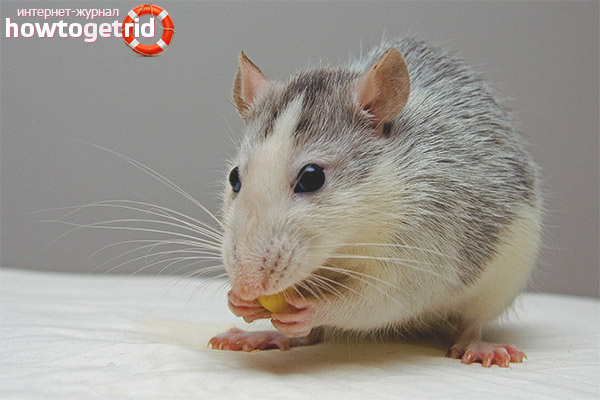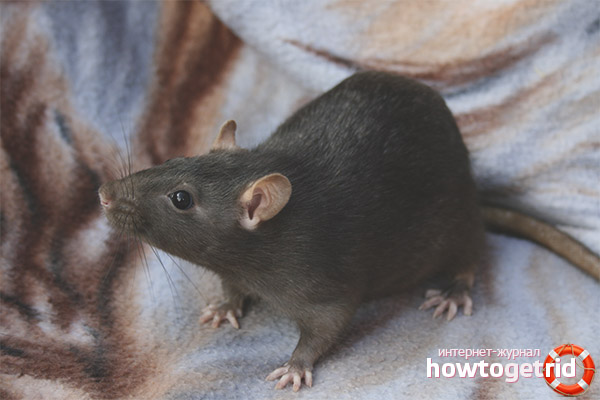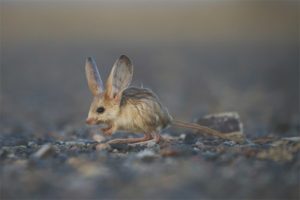The content of the article
A rat is a rodent that belongs to the Muridae family. There are several types of rats. The most common of which are black and brown. This animal has a very strong sense of smell and hearing. The rodent has a characteristic sharp muzzle, and two sharp incisors in the jaw. The animal is very sensitive and well oriented in space.
Relationship between rats
The social organization of rat colonies consists of complex interactions. This allows rodents to quickly adapt to change. The behavior of each individual depends both on its physical characteristics (gender, size, etc.) and on their previous experience. Thus, the dominant male must win by turning a relative on his back and putting his legs on his chest. Also, the winner can urinate on the opponent. Once these hierarchical relationships are established, territorial problems in the social group disappear.
In this way, social relationships between rats are built that prioritize food or nesting. There are those individuals who enjoy the benefits in the first place, those who are waiting in the wings, and finally, those who are rejected by the rest of the colony — they must live separately from the community. But the social organization of rat communities cannot be associated with a simple and unshakable scale of dominance. In fact, the status of a rat is not fixed, but depends on its social environment.
Communication
Since rats are social animals, they need to maintain social ties and exchange information with each other. They can communicate in different ways, for example:
- Voice communication. Rodents make sounds on two levels: sound and ultrasound. Vocalization perceived by man is a small part of the sounds that are heard by the animal. Sounds can be very expressive to indicate discontent or protest. Also, rodents make sounds during fights. Ultrasound that is not audible to human ears is intended for distress signals or to alert a danger to the community.
- Sense of smell. Like other social animals, rats use odors to convey many olfactory messages. In particular, urine pheromones allow information to be transmitted throughout the colony. During puberty, males leave small drops of urine in their path. Females can then pick out the smell of their companion. Another method of transmitting information is carried out using secretions from special odorous glands. Rodents rub these secretions into objects of their environment.
- Sniffing. By smell, rodents also determine social status. When two rats approach each other, a kind of communication code is established between them: one confirms its dominance by sniffing more often, and the other notes its subordination, doing this more carefully.
The two most common rat species
The most common and most dangerous for humans are two types of rats - brown and black. Both are larger in size than mice, but rarely weigh more than 500 grams. The black rat is slightly less brown, and less common. Both species come from Asia and arrived in Europe at different times, in particular, brown rats arrived in Europe at the end of the Middle Ages. They also managed at one time to move to other continents - to America and Australia on board the ships of the settlers. For this reason, they are sometimes called "rats of the Old World."
Depending on the type, they live on the upper floors of buildings, basements, as well as in sewers.The rat is a very prolific animal, and in the absence of predators, a rapid overpopulation of rodents usually occurs. They can damage crops, food stocks in warehouses or in stores. In addition, these animals can cause damage to electrical wires, bite cables, provoke fires, damage the insulation of buildings. Also, rats sometimes become the culprits of the destruction of buildings, as they can gnaw on the foundation, thereby weakening the structure. They can also gnaw pipes and, therefore, leak water or gas.
Black rat
- The pointed muzzle is triangular in shape.
- Big eyes.
- Large thin, mobile, translucent, rounded ears without hair.
- 4-finger forelegs.
- 5-toed hind legs.
- Dark gray or gray-black fur on the back, the abdominal part is lighter.
- The tail is long, conical, dark gray, scaly (about 260 rings), usually longer than the body.
- 16 teeth.
- Length up to 45 cm.
- Weight from 130 to 180 grams and only rarely reaches 220 grams.
Breeding
Black rats reach puberty in a period of 2 to 5 months. Pregnancy lasts an average of 22 days. Cubs are born blind and hairless, their hair appears after 7 days, and they open their eyes after 12-14 days. They lag behind the chest after about 3-4 weeks. The average number of litters per year is 4-6, each brings an average of 6-8 cubs. On average, their life expectancy is 9-12 months.
They have rather poor eyesight, they are practically blind, but their hearing, smell, touch and taste are highly developed. Black rats are good runners, excellent climbers and riders, and if life forces them, then good swimmers.
Habitat, lifestyle and nutrition
Black rats are found in the fields, and especially they like to nest on high-rise buildings. If the brown rat prefers cellars and cellars, then the black one in such premises is uncomfortable. These are very dexterous animals; they like to settle in attics, especially high-rise buildings. Very rarely, they can be seen nesting in cellars or sewers. In the open air, they prefer to live above ground level, for example, on trees, but sometimes they can be found in burrows or under vegetation around buildings. Rodents are nocturnal. They are social animals and live in groups that can count more than fifty individuals.
Black rats prefer products of plant origin: fruits, vegetables, cereals, seeds, root crops and animal feed. Black rats usually follow the same route or path between their shelter and sources of food and or water.
Brown rat
Brown is another species of rat that poses a danger to humans. Many believe that this species comes from Norway, but in fact it is not. The rodent came from Asia, China and Japan. He arrived in Europe in the eighteenth century, gradually crowding out his "cousin black brother." This species does not have normal contact with people - on the one hand, because it harms crops and other crops, and on the other hand, because these animals are carriers of dangerous diseases.
The way of life of a brown rodent, a very similar way of life of a black rat, is that both species prefer to live in colonies near a place where there is water, but unlike a black colleague, brown rodents are very poor climbers, so they do not nest in attics . These animals prefer to settle in underground rooms or on lower floors, as well as in pipeline networks.
In many respects, brown rats are similar to black rodents, so it is worth noting only distinctive properties.
Characteristic
- The animal is quite large and belongs to the murid family.
- The rodent has a rather long body - about 25 cm, tail about the same size.
- An adult weighs about 350 g. Therefore, this species is larger and heavier than its relative, a black rat.
Habitat, lifestyle and nutrition
This species is omnivorous. Rodents are very well adapted to life near people and eat food that they find in the house. The rodent leads a night life. You can notice his presence only quite early in the morning or at dusk. He is looking for food in sewers or landfills. He digs holes and lives close to people's places of residence. His diet mainly consists of fruits, cereals and meat. Rats live in colonies in which their own rules of conduct are established.
A rodent can urinate on its relatives. This is a demonstration of dominance and a way to identify your place in the social hierarchy. There are cases when dominant individuals urinate against each other - this shows that they are equal in rights and accept each other with such a gesture.
The brown rat has a rather aggressive behavior. This animal can attack the one who will disturb him.Rodents is a formidable opponent in battle: an excellent runner, he can overcome 100 meters in less than 10 seconds, is able to jump up to 2 meters in length and swim for about 72 hours.
Why are rats dangerous?
Rats have taken their place in history as distributors of the extremely dangerous bubonic plague. Although infection today is quite rare, cases of the disease are still sometimes observed. Rats can also carry fleas and spread diseases such as typhus, infectious jaundice, fever, trichinosis and salmonellosis. In addition, rodents can cause food poisoning by contaminating the surface of food or cooking tools.
Like many other types of rodents, rats can be aggressive if they feel threatened. In self-defense, they can bite and even chase their offender. Diseases can be transmitted if the rat manages to bite or scratch. Symptoms of infection through a rat bite include vomiting, headache, fever, muscle and joint pain. Therefore, you need to be very careful when meeting with this rodent.
Video: Interesting Rat Facts












Submit